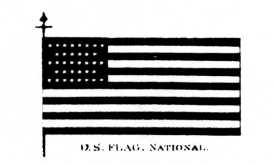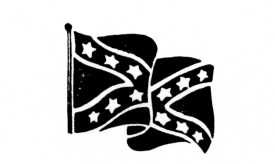OUR CLAYBROOK HERITAGE
(Madison County, Tennessee)
By Jonathan K. T. Smith
Copyright, Jonathan K. T. Smith, 1993.
CIVIL WAR
(Page 35)
The unfortunate conflict generally known as the American Civil War, 1861-1865, its local aspects and leading events in Madison County (and "the days of reconstruction" thereafter) have been interestingly presented by Emma Inman Williams in HISTORIC MADISON to which the reader is referred.[1]
In the relatively few diaries and letters that have surfaced for this period, directly related to Civil Districts 12 and 13, but chiefly in the oral traditions of the families of this area, the war is remembered as a time of oppression, stagnation and economic loss. Aside from the burning of a considerable part of Jackson's business district in February of 1864 by Federal forces there was little reported destruction of large properties in the county during the war.[2]
This area fell into the control of the Federals in March of 1862 and Jackson was formally occupied by them for one year, June 6, 1862-June 6, 1863. Their presence, however it may have been lamented at the time, is likely to have stabilized this locality as partisans were less apt to prey upon the citizenry as happened so viciously in adjoining Henderson County. It was perhaps inevitable that farms and plantations would be raided by the Federals, principally from the Quartermaster officers, who took livestock, cattle and horses, swine, mostly; corn and wheat, smokehouse meats as well as occasional theft of more personal items. When these "raids" were made by official orders people were given vouchers for the goods taken from them, supposedly to be turned in to Federal authorities for cash payment. Local people had to accept the stern realities of war and had reason to be thankful that few atrocities were committed in their midst by Federals or Confederates.
The Federal and "Rebel" forces met in a skirmish, December 20, 1862 around the Old Salem Cemetery, a few miles east of Jackson. One planter, Martin B. Key, who lived on the Jackson-Lexington Road, wrote in his pocket diary that on this day the Federals had "halted at my house" and had taken a hundred pounds of salted pork, all the back and spare ribs on hand and several other items.[3] This can hardly have been an isolated "raid", even on this occasion, revealing how the citizenry were "participants" indeed in the war.
Even before Tennessee had seceded from the Union in June of 1861 its chief authorities had committed the state and its resources to the Confederacy. The county court of Madison County appointed "Minute Men", by civil districts, who would go to the defense of their communities and assist in providing for needy families of soldiers in their midst. Colonel William M. Dunaway, a highly respected Cumberland Presbyterian minister, served as commander of the local defenders, whose services were nominal and after March of 1862 practically nil. The "Minute Men" in Civil Districts 12-13:
|
CONFEDERATE "MINUTE MEN" APPOINTED BY THE MADISON COUNTY QUARTERLY COURT, MAY 17, 186l; by civil districts, those citizens who would "rush" to protect their communities from military invasion and a provision also to provide for needy families of regular soldiers. Colonel William M. Dunaway was Commander-in-Chief of those Minute Men. (WEST TENNESSEE WHIG, May 17, 1861, p. 3) DISTRICT 12 L. Day, Jesse Gray, W. T. Key. J. M. Barnett. Ed. Willis, S. F. Puckett, J. H. Lanier, R. M. Mason, Alex. Askev, G. W. Haughton, W. H. Jackson, Wm. Blackmon, M. B. Key. W. C. Hutchinson, J. W. Fisher, J. W. Lewis, E. A. Clark, L. B. Herron, Jas. Oliver, A. H. Gaston, John Herron and J. C. Rogers DISTRICT 13 Peter McCollum, R. D. McCallum, John M. Neil, John M. Philips, C. C. Sharp, James M. Thomas, Eli McCorkle, L. C. Smith, Joseph C. Sharp, James M. Sharp, Wilson L. Winfree, Burton L. Hudson, Sydney Moore, Wm. B. Ewell |
(Page 36)
It was perhaps a legitimate local brag that Madison County furnished more soldiers for the Confederacy than it had registered voters. Companies of local men were supplied for several regiments and individuals enlisted in other outfits. The celebrated SIXTH TENNESSEE INFANTRY REGIMENT, CSA, was organized in Madison County and largely filled with men from that county.
The flags used by the soldiers in the War of the Sixties.
|
A. The national flag, with stars representing the southern states still intact as they were considered "still" in the Union but insurrectionary. |
B. The Battle Flag of the Confederacy. |
The Sixth Tennessee Infantry Regiment, CSA, "was composed of eight companies from Madison and one each from Fayette and Haywood counties.[4] These companies, including Company B, Captain John J. Brooks, with men from Civil Districts 12, 13, 14 were mustered into state service, May 15, 1861, at Camp Fair, soon renamed Camp Beauregard. The camp was laid out on the fairgrounds, just west of Jackson, hence its having been called Camp Fair. Here the young men were drilled; morale was reported high among them. The regiment, some 1200 strong, left Jackson for Union City; saw first actual combat in Missouri and Kentucky; suffered 500 casualties at Shiloh, April 6-7, 1862. The regiment was reorganized at Corinth, Mississippi, May of 1862. This regiment served in some of the fiercest-fought battles of the war, including Murfreesboro, Chickamauga, Missionary Ridge, Atlanta, Franklin; the regiment became part of Company A, First Consolidated Tennessee Infantry Regiment, April 9, 1865; surrendered at Greensboro, North Carolina, May 1, 1865.[5]
|
OFFICERS JOHN J. BROOKS, previously a Major-General of Tennessee Militia: he wanted to organize a regiment of infantry in the fall of 1861 but this not materialize, although he had considerable support from leading authorities on the local level for this movement; he resigned from service. November 27, 1861: succeeded by George G. Person and later, he by N. T. Parham. |
|
PRIVATES J. A. ALEXANDER. wounded at Perryville, October 6, 1862: described as 6'1; deserted his unit at Chattanooga. August 23, 1863: discharged and paroled by Federals, September 26, 1863. |
(Page 37)
|
J. M.BUMPASS, died May 19, 1862. NOTE |
UNITED STATES DIRECT TAX COMMISSION
DISTRICT OF TENNESSEE
Assessment of lots and lands and other proceedings; representative properties in Civil Districts 12 and 13 and a few in 14 of Madison County (persons, properties with tie to the Claybrook area); under act of U.S. Congress entitled, "An Act for the Collection of Direct Taxes in the insurrectionary districts, within the United States and other purposes, approved June 7, 1862 and the acts ammendatory thereto." Taxes assessed by Federal authorities for 1865, collected early in 1866:
|
Name of Owners |
Lots/Acres |
(Cash) Value ($) |
|
CIVIL DISTRICT TWELVE |
||
|
BARNETT, J. M. |
300 |
4,500 |
|
CIVIL DISTRICT THIRTEEN |
||
|
CLARK, J. F. |
1,055 |
11,361 |
|
CIVIL DISTRICT FOUJRTEEN |
||
|
WLLIS, Abel |
122 |
1,500 |
(Page 38)
REFERENCES
1. HISTORIC MADISON, by Emma Inman Williams (Jackson, 1946), Chapter 13, "The County and the Sectional Conflict," pages 156-189; Chapter 14, "The Days of Reconstruction," pages 190-197.
2. This was an episode vividly described by Robert H. Cartmell, whose home-place was located just east of Jackson, off East Chester Street. TSLA, Nashville: R. H. Cartmell Diary, volume 3 (1863-1867), pages 57-58 (entry, February 21, 1864).
3. FAMILY FINDINGS, Mid-West Genealogical Society, Jackson, Tennessee, vol. 14, #4, October 1982, page 132. Diary of M. B. Key, December 21, 1862 entry.
4. THE MILITARY ANNALS OF TENNESSEE, by John B. Lindsley (Reprint, Spartanburgh, S.C., 1974), page 204.
5. IBID., pages 204-225.
6. National Archives, Washington, D.C.: Compiled Military Service Records of Confederate Soldiers, Tennessee. M-Roll 139, A-D; M-Roll 140, E-K; M-Roll 141, L-R; M-Roll 142, S-Z.
Return to Contents

